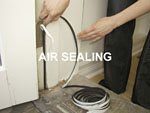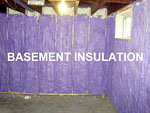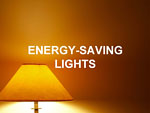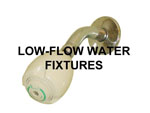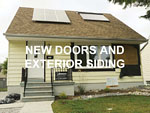the retrofit - upgrades to wartime houses
The first of the Now House Windsor 5 houses was completed in May 2009 as part of the Ontario Energy Conservation Week. This first retrofit was partially sponsored by the Ontario Power Authority.
The additional four houses were retrofitted from June to August 2009 with Windsor Essex Community Housing residents moving back into the homes in early September.
The houses were retrofitted in an assembly-line fashion commencing with air sealing and insulation. This was followed by HVAC changes, solar systems (depending on the house), windows and doors, #1b65a5, lighting and low flow water fixtures. Near the end of the retrofit a siding sponsor came on board, so just prior to the official launch of the homes in October each home was provided with new siding.
Air sealing & Insulation
Air sealing and insulation are the most cost effective ways to improve energy efficiency. Air sealing stops cold air from entering the home in winter and keeps hot air out in summer.
The energy audit and the infrared imaging helped identify where the homes were leaking energy and helped us assess where air sealing and insulation would be required.
Caulking, weather stripping and spray foam was used to seal all air leakage identified in the energy audit.
Air Sealing
Caulking, weather stripping and spray foam was used to seal all air leakage identified in the energy audit.
Insulation
Attic: Two inches of foam insulation were sprayed on the floor of the attic providing an insulation value of R12. Cellulose spray foam was added on top to increase the insulation value to a total of R50.
Exterior walls, ground floor and second floor exterior walls were insulated from the inside.
They were prepared for cavity fill spray foam by drilling a series of holes in the walls. Holes were drilled between studs in the top and mid-point in the walls. Approximately 4" of spray foam were added to the cavity. The holes were then plugged, plastered over and sanded in preparation for painting. The walls now have an insulation value of R24.
Basement
There is a lot of preparation required for insulating the basement. All equipment had to be moved away from the basement walls, for example, duct work, the electrical panel, water meter, laundry sinks, and plumbing pipes. This is done so that a complete air barrier can be created when the walls are spray foamed, therefore, permitting no thermal bridging.
The basement walls were examined and all cracks filled prior to insulating. Flaking paint, dust, cobwebs or debris were scraped from the walls. Prior to applying spray foam, 2 x 3 wood frames were built on the interior of the basement walls. The frames were built allowing a 1” airspace between the wall and the frame. This space allows spray foam to flow behind the frame.
Heating, Cooling, and Ventilation
Once the insulation was completed, the heating and cooling required to keep our homes comfortable was greatly reduced. The heat load was recalculated in order to determine the size of the new HVAC system.
A gas fired, hydronic forced air heating system was installed to work in conjunction with the solar thermal system. Without a hydronic heating system, the solar thermal system cannot be used to augment home heating; it could only be used for heating hot water. The furnace is referred to as a clean air furnace as it includes a built in heat recovery ventilator (HRV). The purpose of the HRV is to ensure ventilation in the home. Now that the house is air tight, and air is no longer coming into or out of the home through leaks in the home envelope, the air must be mechanically ventilated to ensure good air quality.
Appliances, Lighting, and Water Use
How much electricity we use depends on our lifestyle and on the energy efficiency of the #1b65a5, lighting and water fixtures in our home. ENERGY STAR rated #1b65a5; new CFL lighting and water-saving fixtures can greatly reduce both electricity and gas usage.
Water Use
Added water saving fixtures in the home. All water-related fixtures were replaced with low flow fixtures. The bathroom sink and kitchen sink have aerators, and the showerhead is a low flow fixture. A low-flow toilet reduces water usage from 26 litres to 6 litres per flush.
Solar photovoltaic panels
Solar photovoltaic panels (PV) convert the sun’s power to electricity. Electricity from the panels can be used in the home in a net metering arrangement with excess electricity credited to the electric bill or be grid-tied in which case all energy is sold to the local utility. The PV panels on this house are grid-tied and the Feed-in-Tariff of 80.2 cents/kWh will offset the remaining cost of energy and produce a positive cash flow.
Solar Energy
To achieve net zero energy use, as Now House attempts with every retrofit they undertake, the house has to become an energy producer not just an energy user. The definition of net zero energy use is: a home that produces as much energy as it uses on an annual basis.
To do that requires the use of a renewable energy source; in our case, we used the sun.
Solar thermal system for home heating and hot water.
We installed a closed loop solar thermal system to supplement heat to the hot water tank and the home heating system (used in conjunction with the hydronic furnace). By "closed loop", we mean a system of piping that circulates a liquid (either water or anti-freeze, in our case it’s glycol) through a self-enclosed system. We chose an evacuated tube style solar thermal collector that contains heat-conducting rods.
The rods act as heating elements for the glycol. This collector is smaller and more efficient than traditional flat plate collectors. An evacuated tube has had the air removed to create a vacuum, which results in a very low heat loss once the inside coating has absorbed the solar radiation. A pump moves the glycol through a loop into the solar collector and out again through the collector’s evacuated tubes. The sun-warmed glycol flows into a heat transfer tank where it warms the cool water heading to the hot water tank and the heating system.
The glycol then returns to the pump and again flows into the solar collector without ever mixing with the home's water.
We used a closed loop system with glycol because winter temperatures often go below freezing in Windsor Ontario.
Tankless water heater
We chose a tankless system to eliminate standby energy losses normally associated with a typical hot water tank. This tankless system heats water only when there isn’t adequate heat provided by the solar thermal system.
The system provides hot water for heating and domestic hot water use.
Windows, Doors, and Exterior Siding
The time to replace windows and doors is after the home has been air sealed and insulated. If your home is still leaking energy, new windows will not make a lot of difference.
The windows were replaced with ENERGY STAR rated, double glazed, argon filled, and low-e glass windows. They provide greater comfort, create less condensation and transfer much less heat into the house in summer. The doors were also replaced to improve the level of insulation and improve the home envelope seal.
Siding replacement
The old vinyl siding was replaced with cement board siding. Cement siding is extremely durable and long lasting, resistant to fires, insects and rot. It stands up well from wear and tear associated with extreme climates and provides the appearance of wood siding without the maintenance.






